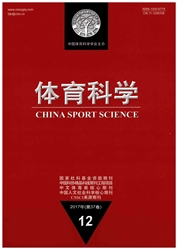

 中文摘要:
中文摘要:
目的:通过对主动肌和拮抗肌功能转变瞬间肌电平均功率频率的观察,探讨中枢控制因素在决定MPF变化中的独立性作用。方法:10名健康男性志愿者在完成60%MVC强度的疲劳性等长屈肘运动负荷试验后,瞬间转变肌肉工作性质,完成60%MVC强度的疲劳性等长伸肘运动,分别记录肱二头肌和肱三头肌的sEMG信号,观察两次疲劳试验以及瞬间转变过程中肌电MPF等sENG指标变化。结果:等长屈肘和等长伸肘快速转变的瞬间,主动肌和拮抗肌MPF等各项sEMG信号分析指标均发生了显著性改变,表现出明显的跃变现象;无论是转变之前,还是转变之后的等长疲劳试验过程中,主动肌与拮抗肌的MPF、C(n)和%DET均表现出类似的变化规律,而拮抗肌AEMG则维持相对恒定。结论:中枢运动控制是导致疲劳过程中MPF单调递减变化的独立性作用因素,其可能的作用机制是CNS将主动肌与拮抗肌作为一组控制肌群实施同步控制。
 英文摘要:
英文摘要:
Objective: The purpose of this study was to explore the independent role of central motor control in the alternations of sEMG mean power frequency during elbow flexion to ex- tension transition. Method: 10 healthy male subjects took part in the experiment, which consis- ted of two phase isometric fatigue loading exercise. In the first exercise, the subject performed elbow flexion as soon as possible under the load intensity 60% MVC, then subject performed elbow isometric extension as soon as possible. Both sEMG activities of biceps brachii and tri- ceps brachii were recorded and then mean power frequency and other parameters were calculat- ed. Result : ( 1 ) During the rapid transition phase, mean power frequency and other sEMG pa- rameters changed significantly. (2)During two phase elbow isometric contractions, both agonist and antagonist muscle showed similar activity patterns of MPF,C(n) and %DET,but AEMG remained relatively constant. Conclusion:The experimental results suggested brain central mo- tor control system displayed an independent role in the alternations of MPF of biceps brachii during fatigue exercise, the possible mechanisms was that both agonist and antagonist were to- tally controlled by the central motor control system.
 同期刊论文项目
同期刊论文项目
 同项目期刊论文
同项目期刊论文
 期刊信息
期刊信息
